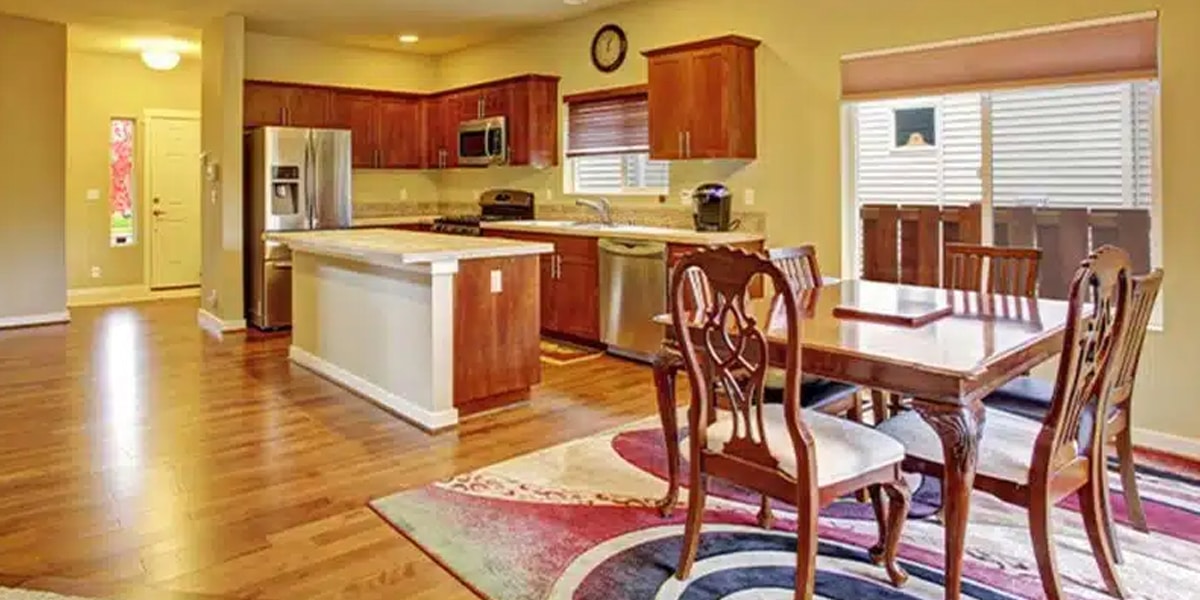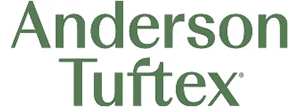Pros & Cons of Hardwood Floors in Kitchens

Hardwood floors in kitchens have become a popular choice among homeowners because of their beautiful appearance and long-lasting durability. If you’re considering this type of flooring for your kitchen, it’s important to weigh the pros and cons.
Hardwood floors in kitchens offer a combination of beauty and durability. However, it’s important to consider their vulnerability to moisture and susceptibility to scratches. By choosing the right type of hardwood, practicing proper maintenance, and being mindful of the environmental impact, you can enjoy the timeless appeal of hardwood floors in your kitchen for years to come.
Difference Between Engineered Hardwood and Traditional Hardwood Flooring?
Timeless Aesthetic
The phrase “timeless aesthetic” encapsulates the enduring and classical allure of hardwood floors when incorporated into kitchen design. This enduring charm is deeply rooted in the historical legacy of hardwood floors, which have been a preferred choice for centuries. Their unwavering popularity persists in contemporary times, and they remain highly sought after for their enduring elegance.
The intrinsic natural beauty of hardwood is a key contributor to its timeless appeal, transforming kitchens into spaces exuding sophistication, warmth, and character. Beyond mere visual aesthetics, hardwood floors bring a unique ambiance to kitchens, fostering a welcoming atmosphere that stands the test of time. The tactile warmth underfoot and the visual richness of hardwood contribute to an inviting and comfortable environment, making the kitchen a central hub of the home.
Hardwood’s enduring popularity can also be attributed to its well-acknowledged durability and longevity. In high-traffic areas such as kitchens, where constant activity, spills, and movements are the norm, hardwood floors prove to be remarkably resilient. Their ability to withstand the rigors of daily life without sacrificing their aesthetic appeal adds a layer of practicality that further solidifies their status as an ideal flooring choice.
The amalgamation of timeless beauty, durability, and practicality forms the cornerstone of hardwood floors’ continued popularity in kitchen design. Homeowners are drawn not only to the visual charm but also to the enduring functionality of hardwood, creating a harmonious balance between aesthetics and utility. As a result, hardwood floors in kitchens transcend fleeting trends, standing as a testament to enduring style and lasting quality in the realm of interior design.
Warmth and Comfort
The distinctive quality of hardwood flooring plays a pivotal role in infusing kitchens with a warm and inviting atmosphere, elevating it beyond a mere functional space to a cozy and relaxing environment. This unique characteristic is a significant driver behind its popularity among homeowners seeking not only aesthetic appeal but also a tangible sense of comfort within their living spaces.
The warmth that hardwood imparts to a kitchen is not merely visual but extends to a sensory experience, creating a tactile comfort underfoot that is both timeless and reassuring. The inherent beauty of hardwood, with its natural grains and tones, adds to the overall charm, transforming the kitchen into a welcoming retreat within the home.
Despite these desirable qualities, there exists a cautionary note that stems from the porous nature of hardwood. While it contributes to the material’s distinctive charm, this porosity makes hardwood susceptible to potential water damage. The risk is particularly pronounced in areas like kitchens, where spills and exposure to excessive humidity are common occurrences. The cautionary aspect serves as a reminder that, despite the comforting ambiance hardwood provides, responsible and attentive care is paramount to safeguard against issues such as warping or cupping.
Proper maintenance becomes an integral part of enjoying the warmth and coziness that hardwood flooring brings to kitchens. Swift action in response to spills, vigilant moisture control, and a proactive approach to addressing any humidity-related concerns become essential practices. By striking a balance between the comforting ambiance of hardwood and diligent care to prevent potential water damage, homeowners can fully appreciate the unique and inviting atmosphere that hardwood flooring imparts to their kitchen spaces.
Value Addition
The decision to incorporate hardwood floors into the kitchen is not merely an aesthetic choice but also a strategic investment that can substantially enhance the overall value of a home. The multifaceted allure of hardwood, encompassing durability, visual appeal, and a timeless aesthetic, holds a compelling appeal for potential homebuyers, elevating the desirability of the property in the real estate market.
One of the key factors contributing to the increased value of a home with hardwood floors is the inherent durability of this flooring option. Hardwood stands resilient against the wear and tear associated with high-traffic areas like kitchens, making it an attractive prospect for homeowners seeking enduring quality. The longevity of hardwood ensures that the investment in these floors extends far beyond mere visual appeal, providing a lasting and practical foundation for the home.
The visual charm of hardwood floors is another significant contributor to their value enhancement. The natural beauty of wood, with its rich grains, warm hues, and timeless elegance, adds a touch of sophistication to the kitchen space. Potential buyers are often drawn to the aesthetic versatility that hardwood offers, seamlessly blending with various design styles and acting as a canvas for personalization.
The timeless look of hardwood further solidifies its desirability. Unlike certain trends that may come and go, hardwood floors maintain a classic and enduring appeal. This timelessness not only aligns with a wide range of design preferences but also ensures that the property remains attractive to future generations of homeowners.
While it’s true that concerns like susceptibility to water damage and additional installation costs may arise, the long-term value and aesthetic appeal often outweigh these potential drawbacks. Homebuyers recognize the enduring nature of hardwood floors and are willing to invest in a property that features this timeless and coveted flooring option. With proper care and maintenance, homeowners can enjoy the benefits of hardwood floors in their kitchens, not only during their occupancy but also in the form of increased property value when it comes time to sell or rent the home.
Easy to Clean
The advantages of solid hardwood floors extend beyond their timeless aesthetic and durability; they also excel in terms of ease of cleaning, setting them apart from alternative materials like laminate or vinyl. The smooth and durable surface of solid hardwood simplifies maintenance, making it a practical and attractive choice for homeowners, especially in spaces like kitchens where cleanliness is paramount.
The straightforward cleaning routine for solid hardwood floors involves several uncomplicated practices that contribute to their overall ease of maintenance. Regular sweeping becomes a fundamental step, efficiently removing loose dirt and debris that may accumulate on the surface. This simple task not only preserves the floor’s appearance but also prevents scratches that could result from particles being ground into the wood.
Vacuuming, preferably with a hardwood floor attachment, is another effective method for maintaining the cleanliness of solid hardwood floors. This process further removes finer particles and ensures thorough cleaning without causing any damage to the floor’s surface.
In the face of spills, a common occurrence in kitchens, solid hardwood floors showcase their user-friendly nature. The impermeable surface allows spills to be promptly wiped away, preventing the liquid from seeping into the wood and mitigating the risk of stains or damage. This quick and efficient cleanup process aligns with the demands of high-traffic areas like kitchens, where spills are almost inevitable.
For a deeper clean and to preserve the floor’s shine, regular mopping with a mild cleaner is recommended. This helps remove accumulated grime and maintains the hardwood’s luster without compromising its integrity. The straightforwardness of this cleaning regimen not only ensures a hygienic environment but also contributes to the longevity and visual appeal of solid hardwood floors.
The ease of cleaning associated with solid hardwood floors makes them an excellent choice for kitchens, where maintaining cleanliness and hygiene is crucial. Their smooth and resilient surface simplifies the cleaning process, offering homeowners a flooring option that not only exudes timeless beauty and durability but also supports a hassle-free and practical approach to maintenance in high-traffic areas.
Disadvantages of Hardwood Floors in Kitchens
Susceptibility to Water Damage
When discussing the susceptibility of hardwood floors in kitchens to water damage, it’s essential to consider the inherent properties of wood. Wood can absorb and release moisture based on its surrounding environment, making it susceptible to damage when exposed to prolonged moisture. Several factors in the kitchen contribute to this vulnerability.
One significant factor is the presence of moisture from spills and leaks. Accidental spills or leaks from kitchen appliances can penetrate the wood floors’ cracks and crevices, leading to warping, buckling, or staining.
Additionally, kitchens often have elevated humidity levels due to cooking activities, which can result in moisture accumulation on the surface of wood floors. Unlike other areas in a home where rugs or mats act as protective barriers, kitchen floors are frequently directly exposed to water.
To minimize the risk of water damage, proper maintenance of hardwood flooring in kitchens is crucial. This involves promptly cleaning up spills, ensuring adequate ventilation to control humidity levels, and using protective mats or rugs in high-risk areas. Installing a vapor barrier between the wooden subfloor and the hardwood floor can provide an extra layer of defense against moisture infiltration.
Scratches and Dents
Despite hardwood flooring‘s durability, it is susceptible to scratches and dents over time, particularly in kitchen areas. Furniture or appliance movement can cause scratches, while heavy objects dropped on the floor can result in dents, compromising both appearance and strength.
Regular maintenance is essential to prevent further damage and preserve the longevity of hardwood floors in kitchens. This includes using protective pads under furniture legs, regular sweeping and vacuuming to eliminate dirt and debris that may cause scratches, and promptly addressing spills or stains.
Periodic refinishing or sanding can also be employed to reduce the visibility of scratches and dents, restoring the floor’s original appearance.
Cost
The installation and maintenance of wood surfaces in kitchens come with varying costs influenced by factors such as wood type, kitchen size, and additional expenses like refinishing or repairs. Key considerations in assessing the cost of hardwood flooring for kitchens include the type of wood chosen, where exotic woods may be pricier than domestic varieties, and the option of engineered hardwood, generally more affordable than solid hardwood.
The kitchen’s size also affects costs, with larger areas incurring higher installation expenses. Budgeting for kitchen flooring should account for these considerations, along with potential additional expenses for refinishing or repairing existing wood floors.
Installation Challenges
Installing wood surfaces in kitchens presents specific challenges, including addressing moisture barriers, uneven subfloors, and complex layouts. Proper preparation of the subfloor is critical to ensuring a stable and level base for hardwood flooring. In cases of uneven subfloors, additional measures like self-leveling compounds or plywood underlayment may be necessary. Moisture barriers are essential in kitchens to safeguard against water damage caused by spills or high humidity levels.
Complex layouts with islands, cabinets, and appliances may require special tools and techniques for cutting and fitting the hardwood properly. Careful selection of the finish applied to the hardwood floors is also important, as it should provide durability against frequent foot traffic, spills, and stains while maintaining an attractive appearance.
Ultimately, proper installation is indispensable for ensuring the longevity and functionality of hardwood flooring in kitchen environments.
Best Types of Hardwood for Kitchen Floors
When embarking on the task of selecting the most suitable hardwood for kitchen floors, oak, maple, and hickory emerge as highly recommended choices, primarily due to their exceptional durability and notable resistance to moisture.
These hardwood varieties, namely oak, maple, and hickory, exhibit outstanding durability that renders them exceptionally well-suited for kitchen floors subjected to frequent and rigorous use. Their inherent strength is a standout feature, providing the resilience needed to withstand the challenges posed by heavy foot traffic—a critical consideration for a space as actively utilized as the kitchen.
An additional and pivotal advantage of opting for oak, maple, and hickory lies in their natural resistance to moisture. In the dynamic environment of a kitchen, spills and water splashes are common occurrences, necessitating flooring materials that can endure consistent exposure to moisture. The innate moisture resistance of these hardwood options significantly mitigates the risk of potential issues such as warping or damage stemming from water exposure, ensuring a flooring solution that stands up to the demanding conditions of a kitchen.
Beyond their practical merits, oak, maple, and hickory offer a diverse and appealing range of styles. This versatility in aesthetics allows homeowners the freedom to choose the hardwood variety that seamlessly complements the overall design and ambiance of their kitchen. Whether one is drawn to the distinctive grain patterns of light-colored oak, the rich and warm hues characteristic of maple, or the rustic and charming appeal of hickory, these hardwood options provide a broad spectrum of choices to cater to different kitchen styles and individual preferences. In essence, the selection of oak, maple, or hickory for kitchen flooring not only ensures practical benefits but also affords a harmonious integration of style, enhancing the overall visual appeal of the kitchen space.


















